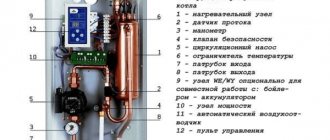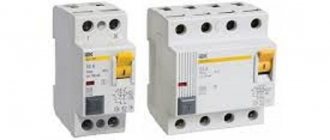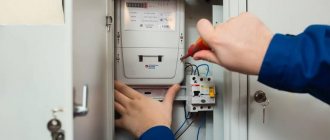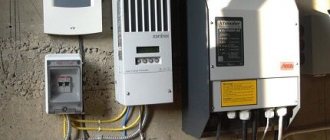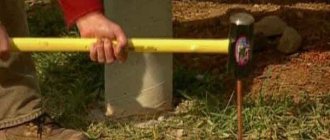Heating a private home with electricity is considered one of the most convenient heating methods. Thermal units that consume electricity are environmentally friendly, quiet and highly efficient, and do not require constant attention from the homeowner. Thanks to this, many of them purchase electric heat generators as the main or additional source of heat. Our task is to tell you how to install an electric boiler and connect it to the utility networks of the house.
Power Supply Requirements
The rated power of electric boilers for a private home ranges from 1.5 to 36 kW.
Such a consumed load on the electrical network requires a dedicated line to connect the converter.
The power cables to it are laid directly from the metering device (electricity meter). For emergency or scheduled generator shutdown, automatic switches are used, which in parallel act as a fuse in the event of a short circuit.
It is possible to connect models with a power of up to 9 kW to a single-phase network; more powerful equipment operates on three phases.
Please note: the boiler must be connected to a grounded electrical network
How to calculate the power of an electric boiler
Before buying a boiler, you need to calculate the required power. The boiler power must take into account electricity limits. Due to the limitation of electricity supplied by local electrical networks, if consumption exceeds the circuit breaker, the circuit breaker is triggered, and the heating system of the house may be de-energized. Thus, when choosing a boiler power, you should be guided by calculations and not exceed it.
A limitation may be the cross-sectional area of the supply electrical cable. When choosing a single-phase or three-phase boiler, it is necessary to check that the power of the equipment matches the cross-section of the installed cable. In addition, boilers with constant and variable (modulated) power are offered on the market. The former are more preferable because they cannot allow excess electricity consumption.
An approximate calculation of power takes into account the area of all heated rooms in the house and is done according to the formula: M = P x Where. / 10m2
where M is the power of the electric boiler (kW);
P – area of heated premises;
Where. – specific boiler power, depending on the region:
- for cold climates Kud. 1.2 – 2.0
- for moderate 1.0 - 1.3
- for southern regions 0.7 – 0.9
As practice shows, to heat a house with an area of 100 m2 in the middle zone, you need an electric boiler with a capacity of at least 100 x 1/10 = 10 kW. In addition to power, heating equipment can be selected according to the area and volume of the house.
How to calculate the power of an electric boiler based on the area of the house
The simplest method for selecting equipment based on the area of the house is based on determining the standard heat loss per meter of heated area. But the standards for small buildings up to 200 sq.m. of heat loss per 1 m2 of area are 0.1 kW. With a house area of 100 m2, the estimated amount of losses will be 0.1 x 100 = 10 kW. Adding 20% to the resulting heat losses (adjustment for abnormal cold), we get 12 kW.
Thus, for a house of 100 m2 you will need an electric boiler with a capacity of 12 kW. Accordingly, for a house with an area of 150 m2, the required boiler power will be: 0.1 x 150 x 1.2 = 18 kW. For a house with an area of 200 m2: 0.1 x 200 x 1.2 = 24 kW
How to calculate the power of an electric boiler by room volume
Calculation of the power of an electric boiler for heating a house by cubic capacity is based on a norm of 4 - 8 Wh of electricity per unit volume. The result of the final calculation depends on the heat losses of the entire house and the specific value of these losses during the season. The additional coefficient in the calculations depends on heat loss through the walls of the house, windows, pipelines laid in cold rooms, etc. The estimated duration of the heating season is 7 months.
Using double tariff
When using an electric boiler as the main source of thermal energy, you can save on bills by installing a two-tariff meter.
There is a special electricity metering system in which at night the tariffs for electricity consumption are reduced (up to 4 times). This is a good way to reduce costs, but you will have to slightly change the operating mode of the boiler.
At night, water is heated, which maintains its temperature while in a thermally insulated container. During the day, hot water is used for household needs, and at night its supply is replenished again.
It is necessary to take into account that this option is only good for double-circuit boilers that simultaneously heat both the coolant and hot water. For single-circuit models, this method gives too little effect, and given the high cost of the meter, there may be no savings at all. In addition, tariffs differ in different regions, therefore, before deciding to use a two-tariff meter, it is necessary to calculate the possible savings and decide whether this idea makes any sense.
Electric boiler for a summer residence - the final choice
Having decided on the brand, the consumer will have to solve another dilemma, namely, answer the question: install a 380V electric heating boiler at the dacha or give preference to a model that operates with a 220V mains voltage? It is worth understanding that the first option requires good wiring that can cope with high loads. Therefore, owners of old country houses with poor wiring should refuse the idea of using a 380V electric heating boiler for heating, the price of which is about $500 for a 6 W model.
Summing up the consideration of the option of heating a dacha using electric boilers, we can highlight a number of nuances.
The advantages of the devices include:
- quiet operation;
- high efficiency;
- no need to obtain permits;
- simple installation and simple operation process.
The disadvantages of devices should also be taken seriously:
- high electricity consumption;
- a solid investment in purchasing a quality boiler from a reliable manufacturer.
Advantages of an electric boiler
Why is an electric boiler so good and why is it distinguished from other options? Well, for starters, it’s worth highlighting at least the simplest things, such as small dimensions, environmental friendliness and the almost complete absence of noise during operation. That is, you can easily install such a boiler in your kitchen, without puzzling yourself with the question of whether you need to look for a separate room for the boiler room.
It is thanks to its small dimensions and weight that the electric boiler is easy to transport and install.
True, there is one strong caveat - using electricity to heat a house is quite an expensive business, so weigh the pros and cons before you go shopping.
Advantages and disadvantages
The positive qualities of electric boilers include:
- complete silence during operation;
- there are no odors, danger of fuel ignition and other threats;
- boilers can be repaired, and the cost of repair is much lower than the restoration of other types of units;
- The dimensions of the boilers are small and allow them to be placed at any convenient point in the heating circuit;
- there is no need to allocate a separate room;
- no need for a chimney, passage through walls or ceilings.
The disadvantages of electric boilers are considered to be:
- a unit power of more than 5 kW requires the use of a 380 V connection, which is not easy to obtain;
- complete dependence on power grids;
- for connection you need a separate line with high-quality wiring and residual current circuit breakers;
- The efficiency of electric boilers is relatively low;
- Electricity tariffs are high and vary by region.
The efficiency of electric boilers is low, but induction models are an exception - their coefficient reaches 98%.
General recommendations
Many users are concerned about the room requirements for the heat generator. The existing regulatory framework does not make any requirements regarding where the unit should be located and whether a separate room is needed for it. However, there are Rules for the Construction of Electrical Installations (PUE), and they should be followed when installing this type of water heaters.
If you want to do everything right and ensure electrical safety in your home, then it is recommended to follow the following rules for installing the boiler:
The unit is best placed in a furnace or other technical room. Then no one living in the house (especially children) will be able to accidentally gain access to electrical power equipment. An exception is factory-made heating element boilers, which can be installed in the kitchen;
Do not lay power cables under water supply or heating pipes. In a situation where this cannot be avoided, all measures must be taken to protect the cable from water getting on it, for example, by enclosing it in special mounting boxes made of plastic or metal;
When connecting the boiler to the heating pipelines, do not allow the latter to load the body of the unit with their weight. Pipes must be securely fastened to the walls;
Observe the cross-section of the power cable cores corresponding to the power consumption and current strength. The body of the electric boiler must be connected to the ground loop.
It must be said that installation schemes for electric boilers vary depending on the type of unit used. At the moment, the following types of electrical installations can be used to heat a house:
Boilers with traditional heating elements (heating elements) usually represent a real micro-boiler house enclosed in one housing. The device includes a circulation pump, automation and safety equipment, and in some models a heating element for domestic hot water. Thanks to this design, the installation of an electric boiler with heating elements is significantly simplified. In turn, electrode and induction heat generators are water heating elements that require external piping.
Connection of an electric boiler with other types of equipment and a heat accumulator
Let's look at how to connect an electric boiler with solid fuel equipment. This option is convenient for owners of country houses where interruptions in the power supply to the network are possible.
Procedure:
- In a network with a solid fuel boiler - it is the main worker, the electrical equipment acts as an auxiliary one.
- When wood or coal is burned, the air temperature in the room decreases, the electric boiler starts working when the temperature reaches below the standard level. The operating mode is set by the user himself, setting the cooling and heating temperatures according to his own preferences.
- The thermostat will detect a decrease in temperature in the return pipe going to the solid fuel boiler and turn off the equipment pump.
- As soon as the owner loads a portion of firewood into the firebox, heating of the heat exchanger of the solid fuel boiler will resume, and the thermostat will start forced circulation of water. In the process of starting liquid transportation, the electric boiler “recognizes” the heating of the coolant by sensors and does not start heating until the next moment the temperature cools to lower limits.
In this way, a floor-standing or wall-mounted electric boiler can be connected to heating with any other types of heaters. The main nuance is that equipment powered from the mains is considered backup; another heat source will be the main one.
To accumulate thermal energy, a buffer tank is inserted into the network; this is a heat accumulator, where the coolant is constantly maintained in a hot state. Such a storage device allows you to reduce the cost of servicing the system - tariffs are cheaper at night, the boiler will heat water for distribution to the heating system during the day.
Selecting and preparing a site for installation in a private house
The location of the boiler is not limited, but when choosing it you should follow several rules:
- If possible, it is better to place the device in a separate room to reduce the likelihood of accidental damage or unauthorized intervention in its operation.
- The device should be placed in such a way that there is easy access for its maintenance and piping.
- Wall-mounted boilers with heating elements are mounted at least 1.5 m from the floor level.
- Induction and electrode models are mounted at any height , but only vertically .
- It is more rational to place the lower tube of the device below the heating radiators , which will create better conditions for coolant circulation.
- There should be no high humidity to avoid damage to the electric boiler.
- The device must be protected from accidental contact with water .
- To power the device, single-phase or three-phase power is provided, depending on its type.
The location for installing the boiler must ensure compliance with the minimum distances to other objects:
- to the ceiling - 80 cm;
- to the floor - 50 cm;
- to the walls - 5 cm;
- to the nearest pipes - 50 cm;
- for servicing the boiler from the front - 70 cm.
Before installing the electric boiler, the following work is performed:
- Using shut-off equipment, the access of water to the system is blocked.
- All surfaces are cleaned of dust and dirt.
- The electrical wiring is checked for compliance with the device's specifications and for absence of damage. If a break is detected, the connection is restored and isolated.
Important! It is necessary to ensure in advance that during the installation of the device, children, unauthorized persons and pets do not have access to it.
How to install an electric boiler
Before starting work, all installed elements are checked for integrity and absence of damage that could lead to boiler malfunction. The work is carried out in the following order:
Single-pipe heating circuit with an electric boiler
Single-pipe heating circuit with an electric boiler and a membrane expansion tank (the pump is built into the heater).
How does a single-pipe house heating scheme with an electric boiler work:
- hot water flows from the heater into the pipe (there is only one);
- from the pipe the coolant enters the battery and returns back, being drawn into the general supply flow;
- As a result, all the liquid, having made a circle, returns to the heater.
The problem is that after each radiator the overall flow becomes colder, since the water has given up some of its energy to heat the air. The difference in coolant temperature in the first and last batteries is significant. Judge for yourself if in a two-pipe system the norm for the delta of the supply and return temperatures is considered to be 20 degrees. Approximately the same in a single-pipe. It turns out that in the last room you need to install a larger battery than in the first. And how much - this must be calculated in each case separately.
Naturally, there must be a connecting section between the inlet and outlet pipes of the coolant into the radiator. It is better that it is slightly narrower than the main highway. This is essentially a heating bypass. The option when the feed enters the end of the battery and comes out on the other side cannot be considered a priori. This is a big mistake. If something happens to the radiator, there will be a lot of hassle.
Safety regulations
Before proceeding with installation, you must familiarize yourself with the safety rules. Before connecting the electric boiler to the heating system, you must turn off the power supply; only in such conditions can you proceed with installation.
Do not forget about the safety rules when installing a boiler. This is important: norms and requirements when installing heating boilers in a private home.
In addition, the following must be observed:
- Boilers should not be installed near a water supply or other sources of water;
- During installation work, it is strictly forbidden to use locking reinforcing bars;
- the boiler unit requires grounding;
- before installing the device you need to obtain permission from a special service;
- in case of repairs, contact only specialists;
- use an electrical cable that matches the power of the boiler;
- the device is placed at a distance specified in the instructions;
- the mounting wall must be made of non-combustible material.
How to properly connect an electric boiler to the heating system
Briefly about how to properly install an electric heating boiler in a private house. To begin installation work, we list the basic safety rules that must be observed:
- When connecting the equipment, the power must be turned off.
- The following distances must be maintained between the boiler and the nearest structural elements of the house: to the wall - at least 5 cm, to the ceiling - at least 80 cm, to the floor at least 50 cm, to the nearest pipe - at least 50 cm.
- The front panel must be freely accessible for maintenance.
- The connection network must be three-phase (380 V) to avoid spontaneous combustion and short-circuiting of the wiring.
- Wire connections must be protected from water and sealed. It is better to protect the cable with corrugation or a cable duct made of self-extinguishing material.
Models of electric boilers
The principle of any electric boiler is the conversion of electricity into heat. Electric units are not the most cost-effective, but the efficiency of their use is 95-99%, which is quite good for such units. Such boilers are divided into three types according to the type of coolant. Let's talk about each of them in more detail.
Electric heating element boiler
Electric heating boilers equipped with heating elements operate on the principle of an electric kettle. Water passes through tubular heating elements - heating elements. Acting as a coolant, it passes through the entire heating system, circulating using a pump.
One of the advantages is its compactness, neat appearance and the ability to be mounted on a wall. The installation process will not cause any particular difficulties, and operation is comfortable and simple, thanks to thermostat sensors. Automation allows you to maintain the required heating, focusing on data from sensors that measure the ambient air temperature.
The coolant can be not only water, but also a non-freezing liquid, thanks to which scale will not form on the heating elements, which cannot be avoided by using water.
Attention. Scale formed on heating elements impairs the heat transfer and energy-saving properties of an electric heating boiler. This option for heating a house is also good because it has a low cost.
For the convenience of regulating electricity consumption, it is equipped with several heating elements that can be turned on separately
This option for heating a house is also good because it has a low cost. For the convenience of regulating electricity consumption, it is equipped with several heating elements that can be turned on separately.
Electrode electric boiler
The operating principle of an electrode electric boiler for heating a house is completely different from the previous model. The liquid is not heated by a heating element. An electrode installed in the housing gives the liquid an electrical charge, under the influence of which the molecules are split into negatively and positively charged ions. The coolant has its own resistance, which provides intense heating. Either water or a special compound (similar to antifreeze) is poured into the system.
This type of electric unit for heating a house is completely safe; if a liquid leak occurs, it will simply turn off. Electrode models are very compact (looks like a small cylinder with pipes), equipped with sensors for measuring ambient air temperature, and controlled automatically.
Maintenance of this model comes down to replacing the electrode, since they gradually dissolve as they work, which worsens the heating of the house. It is also necessary to ensure that the circulation pump is working properly so that the liquid in the system does not boil. Correct and efficient operation of an electrode electric boiler for heating a private house is only possible with prepared water - it must have the required resistivity value. Measuring them yourself is not always convenient and easy, just like preparing water. Therefore, it will be easier and more reliable to buy a liquid specially designed for use in electrode boilers.
Electric induction boiler
This type of electric heating unit for the home operates on the basis of induction heating of liquid with ferromagnetic alloys. The inductive coil is located in a sealed housing and does not have direct contact with the coolant, which flows around the perimeter of the device. Based on this, not only water, but also antifreeze can be used as an energy carrier for heating a house. This electric boiler for home heating is not equipped with a heating element or electrode, which improves its efficiency. Also, the absence of heating elements ensures complete safety during operation. This version of the boiler for heating a home is not subject to scale formation, practically does not break and does not leak.
The only disadvantage of induction models is their higher cost and larger dimensions. But over time, the size problem is eliminated - the old ones are replaced by improved models.
In addition to this classification, electric boilers for heating a private home are divided into:
- single-circuit (intended only for heating the entire house);
- double-circuit (provide not only heating throughout the house, but also water heating).
You also need to highlight:
- wall-mounted boilers;
- floor-standing boilers (high-power models are produced).
Features and types
An electric boiler is part of a heating system ; its main function is to heat the home and supply water.
The main task of the device is to transform electrical energy into thermal energy. It should be noted right away that the utility coefficient of such a device is 96-99%, but gas and solid fuel boilers have a much lower figure, which does not exceed 80%. Read also: about the options and advantages of electric heating at home.
All boilers powered by electricity can be divided into rheostat and shadow types. There are also electrode-type and direct-acting units. They work as follows: an electric current passes through water, releasing heat and heating it. The advantages include compactness and absolute safety. In addition, scale practically does not appear in them. The fact is that water molecules in these devices are split into ions.
Induction models are valued for their high efficiency, even though heating elements are not used. Despite the high cost, such units are extremely popular. This is due to their safety. The principle of operation is that the device is assembled from a special material, which, under the influence of current, begins to generate heat.
In this video you will learn how to install a boiler with your own hands:
Like all other heating devices installed in a private home, electric boilers have their pros and cons. The advantages of installing an electric boiler for heating a private home include the following:
- no open flame;
- easily regulates temperature;
- does not leave combustion waste after work;
- compactness;
- high efficiency;
- easy to install;
- does not require a chimney or ventilation system;
- environmentally friendly;
- safe.
All these qualities provide the heating unit with a long service life. Naturally, if you comply with all requirements for care and installation. The main disadvantage is the high price, which not everyone can afford. And installing such units, for example, in country houses is simply impractical.
In addition, the devices stop working if there are power outages. In addition, an electric heating device provokes the formation of scale, and this, in turn, significantly increases energy consumption.
When installing an electric boiler with your own hands, you need to take care of high-quality thermal insulation. In this case, heat will not be wasted, which means you can save on electricity bills.
Heating system elements
But the sizes of such devices are usually quite large, which limits the possibilities when choosing a place to install them. You can assemble a water heating system for a private house with your own hands, but this will require precise calculations and a boiler piping diagram
Such mats are absolutely safe to use and are easy to set up. And please note that if you use antifreeze, it must be changed every 5 years. Except for one thing - the high cost of energy
In addition, electric boilers differ in power. There are the following types of two-pipe schemes: dead-end: the pipeline network is divided into branches, arms along which the coolant moves along the lines towards each other; associated two-pipe system: here the return manifold is, as it were, a continuation of the supply, and the entire coolant flows in one direction, the circuit forms a ring; collector beam. But the sizes of such devices are usually quite large, which limits the possibilities when choosing a place to install them. After passing through the upper radiators, the coolant flows to the lower radiators, and only after that into the return pipe passing along the first floor. The difference usually lies in the fuel used - gas, coal, pellets, firewood. A single-pipe vertical heating scheme for a private house with a gas boiler can be implemented without forced circulation of the coolant.
Comments
Foil is used to distribute heat evenly across the floor surface. Disadvantages: high cost of energy - this is the most expensive of all existing heating methods.
The temperature level will remain at the same values, and it will be comfortable to be in the room. Even if you heat the house yourself, be sure to consult with the designers regarding the type and method. The floor-standing boiler must stand on a flat surface, it must also be non-flammable.
Electricity is traditionally the most expensive type of heating compared to gas and solid fuel. Do you have experience using an electric boiler to heat your home? From there, the coolant goes down to the radiators, gives them part of its heat, and then is sent through the return pipe to the heating boiler. This home heating connection diagram is not complicated. Do-it-yourself installation of an electric boiler Before installing the boiler, you need to choose a place for it that would allow you to easily and correctly install the heating system pipes, conveniently connect, maintain and control the operation of the boiler itself. Electric boiler overview and connection
Connection diagram
The diagram and methods of connecting an electric boiler to the network assumes that when inserting the device into the heating system and installing grounding between the metal from which the boiler shell is made and the brass from which the M6 bolt is made, a good, strong connection is necessary. Before making contact, metal and brass surfaces must be very thoroughly cleaned.
When installing boiler equipment, it is correct to use a room-type regulator, due to such properties as a potential-free output.
If the room that is planned to be heated is much larger than average, or even an entire building, then when choosing, you need to take into account the possibility of constructing a cascade. It is definitely more complicated, so you need to take into account some nuances and follow the following tips.
Photo of a cascade connection diagram for an electric boiler
In order for the devices in the cascade structure to function properly, the terminal of the device that controls the structure is connected to the device that is subject to automatic control control. If the control device is a room-type regulator, then the control contacts are connected to the terminals of the control device.
Advantages of electric heating
The great advantage of electric boilers is the size of the units operating on electricity. All models of electrical equipment are small in size. If you need to heat a small area, you should choose an electrical appliance for wall installation: it is ergonomic and will easily fit into the environment among other electrical units and pieces of furniture.
Connection diagram of the boiler to the heating system
Another advantage in comparison with other heat sources is the absolute wastelessness, first of all, of products formed as a result of fuel combustion, since there is no need for their disposal.
This is the cleanest type of heating device that exists. The absence of waste eliminates clogging of the natural environment. Of course, most power plants that supply electricity operate by burning fuel, and this does not at all improve the environmental situation. But harmful emissions do not enter the environment in your home.
There is no open fire in electric boilers, which increases their fire safety. But certain measures are still needed for this, since the device is a heat source. But in comparison with the measures required when installing units operating on the principle of fuel combustion, they are insignificant.
Electric boilers are easy to install. The installation principle is so simple that even a person without experience and relevant skills can cope with this task.
The easiest installation is achieved by units whose design includes an expansion tank, electrical control and safety devices protected by a housing. To install such a device, it is enough to connect the power supply, place the device itself and turn on the heating.
Electric boiler connection and wiring diagram
Boilers operating on electricity do not require fuel, which means there is no need to create fuel reserves and litter the home with coal, containers with liquid fuel, or firewood. It is enough to connect the boiler using a copper cord to the power line.
Ease of maintenance is another significant advantage. With such a boiler, there is no hassle in monitoring its operation and the amount of fuel in it. You just need to turn on the device. When using a unit that runs on solid fuel, you must add fuel to it at least twice a day and clean it from products formed during the combustion process. Here you do not need to think about heating and operating the device while electricity is supplied.
On a note! You can design such a heating unit yourself. The design of electric heaters is quite primitive, so it is not difficult to recreate it.
Features of boiler installation
If you feel strong enough to install an electric boiler yourself, take the advice of knowledgeable specialists. It is best if the electric heating source is used as a backup - this will allow the resulting heat to be spent more efficiently in the room.
A non-return safety valve, a pressure gauge and an air vent are the elements that you will become familiar with if you install an electrode-type boiler.
If you have an open heating system, then a shut-off valve is installed on the section of the pipeline that comes from the expansion tank.
For grounding, a copper wire with a four-millimeter cross-section is used when connecting the conductor to the neutral terminal of the equipment. It can be found on the boiler body in its lower part.
It is best if the boiler is built into a new system rather than into an existing circuit. Otherwise, the circuit must be rinsed thoroughly using the products intended for this purpose.
After installing the electric boiler, make sure that all rules for safe operation are followed and that the boiler itself operates normally in all modes. In this case, the installation can be considered successful.
Electric boiler connection diagram: reliable protection and energy saving
Greetings, comrades! Do you know how to connect an electric boiler to electricity? Are you interested in what elements should the boiler piping include? Today I want to answer these questions in detail and as clearly as possible and tell you which electric boiler connection diagram will allow you to heat your home at minimal cost.
Diagram of an electrical boiler room with an automatic control system for boiler power.
Before undertaking the implementation of any project, you need to clearly formulate its goals. Here is their list.
Safety
It consists of three components:
Reliable automatic shutdown. The electrical circuit must prevent electric shock to the user and ensure that the power is turned off in the event of a short circuit;
Correct wiring calculation. When the boiler is operating at full power, it should not heat up: high temperatures can damage the insulation
This is especially important when installing hidden wiring;
Overheating of the wiring led to a fire in the basement. The calculation of its cross-section must be taken as seriously as possible.
- Coolant pressure control. As the temperature of water or antifreeze increases, their volume increases. In a closed circuit, this means a rapid increase in pressure, threatening pipes and radiators. The boiler piping circuit must prevent exceeding the critical pressure;
For a closed (that is, not communicating with the atmosphere and operating with excess pressure) autonomous heating system, the norm is 1.5 kgf/cm 2. The maximum permissible pressure is 2.5-3 kgf/cm 2.
Economical
An electric boiler is the source of the most expensive heat among all modern boilers for autonomous heating. The electrical power of a boiler with a minimum error is equal to its thermal power, that is, the price of a kilowatt-hour of thermal energy is equal to the cost of a kilowatt-hour of electricity (at the beginning of 2021 - about 5 rubles).
For comparison, the owner of a gas boiler costs heat 7-8 times cheaper (about 70 kopecks per kWh), and a wood-burning boiler costs four times less (1.2 rubles/kWh).
Relative cost of thermal energy obtained from different sources. Prices change from year to year, but their ratio remains constant.
The main reason for the popularity of electric heating is its complete autonomy
The boiler does not require the owner’s attention from the word “at all”: it is capable of maintaining the temperature you set in the house indefinitely. However, the owner of an electric boiler, of course, wants to reduce electricity bills
I will tell you how to do this in the corresponding section of the article.
Connection diagram of an electric boiler to a 380 V power supply (three-phase)
The general electrical diagram for connecting a 380 V electric boiler is as follows:
As you can see, the line is protected by a three-phase residual current circuit breaker; grounding is necessarily connected to the boiler body.
As usual, according to tradition, I am posting a connection diagram for a three-phase electric boiler with a combination of an automatic switch (AB) plus a residual current device (RCD) in a circuit, which is often cheaper and more accessible than Diff. machine.
It is convenient to select protective automatic ratings and cable cross-sections for three-phase electric boilers of various capacities using the following table:
In three-phase electric boilers, three heating elements are usually installed at once, sometimes more. Moreover, in almost all household boilers, each of the tubular electric heaters is designed for a voltage of 220 V and is connected as follows:
The heating elements themselves are connected to the network as follows: one end of each of the tubular electric heaters is connected by a jumper, the remaining three free phases are alternately connected: L1, L2 and L3.
If your boiler has heating elements designed for a voltage of 380 V, their connection diagram is completely different and it looks like this:
This connection of the heating element of an electric boiler is called a “triangle” and at the same voltage of 380 V, as in the previous “Star” method, the boiler power increases significantly. In this case, a neutral conductor is not required, only phase wires are connected, and the electrical connection diagram looks like this:
How to determine the correct connection diagram for heating elements with a star or triangle and, accordingly, what voltage they are designed for?
If the instructions for connecting your electric boiler are lost or there is simply no way to refer to them, you can determine the correct connection diagram at home as follows:
1. First of all, inspect the terminals of the heating element; most likely, the manufacturer has already prepared the contacts for a specific circuit. So, for example, for connecting a star and heating elements for 220V, three terminals will be connected by a jumper.
Or, on the heating element itself, its parameters are necessarily extruded:
If you cannot find out for sure the voltage for which your electric boiler is designed and the connection diagram for its heating element, but you “really need to” connect it, I advise you to use the “Star” circuit. With this option, if the heating elements are designed for 220 V, they will work normally, and if they are rated at 380 V, they will simply produce less power, but most importantly they will not burn out.
In general, there are different cases, and it is very difficult to cover them all in the format of one article , so be sure to write your questions, additions, stories from personal experience and practice in the comments, this will be useful to many!
Source
Installation and connection
After the heating and hot water circuit with shut-off valves, check valve, safety valve, expansion tank, temperature sensor and heating devices has been assembled, a hydraulic test of the entire system is performed for the tightness of the assembled circuit with the operating pressure of the pump.
The network is filled with water, pressure is created by a circulation pump, and all connections are carefully checked for drips or leaks. All faults are eliminated and we proceed to testing the assembled power supply circuit.
The electrical circuit must be assembled by a certified electrician, who must assemble the circuit with grounding and test the operation of the heating elements and the boiler’s overload protection. To prevent this from happening, install a residual current device.
Connection diagram of an electric boiler to a 220 V power supply (single-phase)
As you can see, the 220 V boiler supply line is protected by a differential circuit breaker, which combines the functions of an automatic circuit breaker (AB) and a residual current device (RCD). Also, it is mandatory to connect grounding to the device body.
If you were unable to find a suitable differential automatic switch or it is simply too expensive in the line of protective automatics you have chosen, you can always replace it with a combination of Circuit Breaker (AB) + Residual Current Device (RCD), in which case the diagram for connecting a single-phase boiler to the electrical network looks like So:
Now all that remains is to select the cable of the required brand and cross-section and the ratings of the protective automatic equipment for proper electrical wiring to the electric boiler.
When choosing, you need to start from the power of the future boiler, and it is best to count with a reserve, because in the future, if you decide to change the boiler, you will no longer be able to choose an older model (more powerful), without serious alterations to the wiring.
I will not burden you with unnecessary formulas and calculations, but will simply lay out a table for selecting cables and automatic protective equipment depending on the power of a single-phase 220 V electric boiler. Moreover, the table will take into account both connection options: through a differential switch and through a combination of Circuit Breaker + RCD.
For installation, the characteristics of a copper cable of the VVGngLS brand, the minimum permissible PUE (electrical installation rules) for use in residential buildings, will be indicated, while calculations are made for a route from the meter to the electric boiler 50 meters long; if your distance is greater, you may need to adjust the values.
Table for selecting protective automatic equipment and cable cross-section according to the power of a 220 V electric boiler
The residual current device (RCD) is always selected one step higher than the circuit breaker paired with it, but if you cannot find an RCD of the required rating, you can take the protection of the next level, the main thing is not to take it lower than required. There are usually no particular difficulties or discrepancies when connecting a 220V electric boiler, so we move on to the three-phase version.
Water heating: heating element type boilers
Electric water heating is considered more efficient than using only simple heating electrical appliances. This heating system uses ordinary water as a coolant. To heat the water to the required temperature, the system is equipped with a device such as a boiler or electric boiler. Domestic boilers, which are used to heat water, are not suitable as the main device of a water electric heating system. The boiler, which is necessary for the efficient operation of the heating system, must have much higher power ratings. To organize an autonomous electric heating system, a wide variety of installations can be used, such as:
- Heating element installations;
- Induction installations;
- Electrode installations.
The most popular are heating element boilers, which can be seen in the photo. The operating principle of such boilers is as follows: the coolant enters the internal tank of such boilers. A heating element is placed in the tank, which will begin to heat up, and its temperature will be transferred to the coolant. Thanks to the circulation pump, the coolant will flow into the heating circuit and then distribute through the final consumption elements, that is, to the heating radiators.
It must be remembered that the most vulnerable point of the boiler is the heating element. It is necessary to choose a boiler in which the heating element is a replaceable component. The heating element may fail in a few years, as it will become covered with scale, and then it will need to be replaced. Most boilers are equipped with automation, which allows you to turn on a certain operating mode. This allows you to significantly save on electricity, since the boiler will heat the water only when it is needed.
Another advantage that electric water heating provides is the fact that the electrical components do not come into contact with water at all. In the event of an accident, the automation will completely turn off the heating element.
Reliable electric boilers for home heating at 220 volts
When preparing the rating of the best household electric boilers 220, a considerable number of various factors were taken into account - the company, power, the possibility of simultaneous supply of heat for heating and hot water supply, the highly economical process of obtaining energy.
Among the best cheap 220V wall-mounted boilers are:
- EVAN Warmos-IV-5. A budget device made in Russia, with a wide range of functionality. Despite its low power of 5 kW, the boiler works very well in a “warm floor” system, and the “anti-freeze” function makes it indispensable for private houses with an area of up to 60 m2, which can be heated shortly before the arrival of residents. As of November 1, 2019, the price of the unit is 15,520 rubles.
- RusNIT 209K electric boilers made in Russia, with designs well adapted to rural living conditions. A boiler with 100% automation of the technological process, smooth adjustment of the heating water temperature in the range from 40 C to 80 C, is capable of efficiently and quickly heating a room area of up to 100 m2. As of November 1, 2019, the price of the unit is 12,890 rubles.
- Thermotrust ST 9 is the best price of the Swedish brand with full assembly in Russia. The 9 kW model is designed for connection to a 220 V household power supply and operates with an efficiency above 93.0%. Despite its budget price, the generator is equipped with block stainless heating elements. As of November 1, 2019, the price of the unit is 11,814 rubles.
The best wall-mounted electric boilers according to the “price-quality” criterion
- Protherm slope 9 kr 13 is new for 2021. Slovak device with soft start and fully automatic process safety. A wide range of powers from 6 to 28 kW, which makes it possible to create a different heating system for an individual house or apartment, using them as the main or backup source of heat supply. It is possible to connect various components to them for control, accumulation and exchange of information - electronic temperature sensors, programmers, solenoid valves and devices for using a diphtariff meter in order to use cheap electricity at night. As of November 1, 2019, the price of the unit is RUB 32,340.
- Vaillanteloblockve 9 is a very stylish heat generator from Germany. All control is performed with one button, and the information is sent to a two-segment monitor. Directly under the glossy protective casing, a powerful potential is hidden - a heating output of 9 kW. As of November 1, 2019, the price of the unit is RUB 37,709.
- STOUT SEB-0001-000018. These boilers from a Russian manufacturer provide the best price-function ratio and are capable of heating a house up to 200 m2. It is thanks to the integrated synoptic thermostat that it is possible to optimize the temperature regime, thereby reducing the specific costs of electrical energy consumption. As of November 1, 2019, the price of the unit is 34,900 rubles.
The electric boiler market is slowly, but still increasing its momentum
To date, consumers have been wary of this choice. In addition, there are many rumors that the devices are expensive and often break down.
This may have been true at the dawn of their development, but today the technology for their production has made great strides forward, leaving many of the shortcomings of the first models behind.
Which boiler to choose?
On the market you can find different types of boilers for heating an apartment or private house. In order not to get confused, you need to have a minimum of knowledge about each of them:
Electrode boilers. Heating of the liquid occurs due to alternating current that passes through it. This type of electric boiler is considered the most convenient. The efficiency of an electric boiler is not lower than 98% - this is what the manufacturers say.
Heating element boilers are the most common devices; heating elements in them perform a heating function. The units have an efficiency of at least 93%. Despite their low cost, heating element boilers have a serious drawback: if the water is too hard, scale appears on the heating elements, and as a result, the boiler’s power decreases.
This is what a standard heating element boiler looks like.
Induction boilers are durable and economical units that have an efficiency of 98%. The design resembles a transformer. Minus - they cannot produce high power for heating.
Induction boilers are great for an apartment or small private house.
Which electric boiler is best for heating a private home?
The popularity of electric boilers is determined by:
- security;
- low cost;
- reliability;
- small in size;
- ease of installation and operation;
- silent operation;
- environmental cleanliness.
To choose and buy the best electric boiler, you need:
- make calculations and determine the required power;
- decide on the type of boiler;
- compare options of the selected type and select the best one.
Let me remind you that before purchasing, you must definitely check the operating mode of the local electrical networks - perhaps the networks will not cope with the required load, and the purchase will be in vain.
When deciding which electric boiler to choose for heating a private home, most consumers choose heating element boilers. They are much cheaper than electrode and induction boilers and are easy to maintain. Judging by customer reviews, the best electric boilers on the Russian market for heating a private home are:
- Polish units “KOSPEL EKCO” with an efficiency of more than 99%. Boilers from this manufacturer are used for radiator heating and can work together with water heaters for hot water supply. The company offers manual models for small rooms, and automatic three-phase models of boilers with a power of more than 50 kW for large rooms. The disadvantage of boilers is typical for heating equipment - scale formation on the heating elements. According to customer reviews, boilers from this manufacturer are very economical and reliable.
- Russian electric boilers are also popular in the domestic market. Boilers of three power levels from this manufacturer operate from a conventional and three-phase network, and, according to customer reviews, are quite reliable.
- Electrode boilers have also proven themselves well. They are more economical than heating elements and allow you to do without thermal elements. The most popular boiler of this group is considered to be the Geyser model, whose power ranges from 9 to 15 kW. Low-power “Ochag” models and large “Vulcan” boilers with a power of up to 50 kW are also known on the market. The disadvantages of such boilers are the risk of electric shock and the mandatory involvement of a specialist to replace the electrodes.
- Induction boilers are represented by Russian models “SAV” from INERA. The price for such equipment is high - from 30 to 160 thousand rubles, which depends on the power (for induction boilers it is 2.5 - 100 kW).
The photo shows a Polish electric boiler “KOSPEL EKCO.R1-6”
Let's summarize
Having understood in detail the structure and operating principle of electrode boilers, several important conclusions can be drawn.
The ability to economically achieve high power levels and quickly heat large volumes of water has a great impact on the overall dimensions of heat generators. Compact devices with minimal weight can be easily installed anywhere in the house.
If there is a need to heat a large room (500 square meters or more), it is quite possible to create a circuit for connecting several electrode boilers. Another positive point should be noted - when installing ion electric heating, permission and control from the boiler inspectorate are not required.
Of all the heating devices existing today, the electrode boiler seems to be the most acceptable solution. Simple and economical equipment can give warmth to our home and heat hot water for domestic needs.
I installed a two-tariff electricity meter on a 220V network. It is in the house together with a gas boiler “hearth - 3″ (Galan). I installed a 20A direct-flow ammeter in the boiler control panel. When the boiler is turned on, Tobratka 42 degrees shows 6A consumption, and the house meter shows 13A, despite the fact that there is only one LED light in the house and the TV is on and absolutely nothing else. I don’t understand what’s funny? Tell me who knows. Write
Yuri Yuri Gorovoy May 18, 2021, 12:07
Contrary to all stereotypes: a girl with a rare genetic disorder conquers the fashion world. This girl's name is Melanie Gaydos, and she burst into the fashion world quickly, shocking, inspiring and destroying stupid stereotypes.
10 mysterious photographs that will shock Long before the advent of the Internet and the masters of Photoshop, the vast majority of photos taken were genuine. Sometimes the pictures captured were truly incredible.
7 Body Parts You Shouldn't Touch with Your Hands Think of your body as a temple: you can use it, but there are some sacred places that you shouldn't touch with your hands. Research showing.
What does your nose shape say about your personality? Many experts believe that you can tell a lot about a person's personality by looking at their nose.
Therefore, when you first meet, pay attention to the stranger’s nose
13 signs that you have the best husband Husbands are truly great people. What a pity that good spouses don't grow on trees. If your significant other does these 13 things, then you can s.
Unforgivable Movie Mistakes You Probably Never Noticed There are probably very few people who don't enjoy watching movies. However, even in the best cinema there are mistakes that the viewer can notice.

